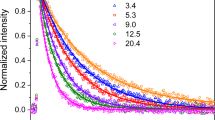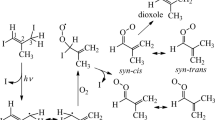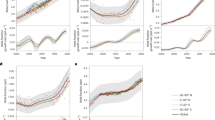Abstract
THE compound 1,1-dichloro-2,2,2-trifluoroethane (CFC-123), which is potentially usable as a foam-blowing agent in the plastics industry, an aerosol propellant and a refrigerant, has been proposed as an industrial substitute for trichlorofluoromethane (CFC-11), the use of which is increasingly restricted because of its effects on the ozone layer and on climate1–3. It is expected that CFC-123, although like CFC-11 an absorber of infrared radiation, will be less stable in the atmosphere because of its expected reaction with OH radicals in the troposphere. Using a three-dimensional global model of the atmosphere, we have calculated the chemical destruction rates of CFC-123 by various processes, confirming that the chief sink is destruction by OH radicals below 12 km, which accounts for 88% of its loss. The calculated destruction rate is greatest in the equatorial region below 2 km. The calculated steady-state lifetime of CFC-123 is 1.5 years, based on the best available estimate of the rate constant of the reaction with OH. This lifetime is very much shorter than that of CFC-11, the destruction of which is largely confined to the stratosphere. For equal rates (by mass) of CFC-123 and CFC-11 emission to the atmosphere, the molar content in the atmosphere and the injection rate of chlorine into the stratosphere are, respectively, 48 and 14 times greater for CFC-11 than for CFC-123 in steady-state.
This is a preview of subscription content, access via your institution
Access options
Subscribe to this journal
Receive 51 print issues and online access
$199.00 per year
only $3.90 per issue
Buy this article
- Purchase on Springer Link
- Instant access to full article PDF
Prices may be subject to local taxes which are calculated during checkout
Similar content being viewed by others
References
1. Rowland, F. & Molina, M. Rev. Geophys. Space Phys. 13,1–35 (1975). 2. Ramanathan, V., Cicerone, R., Singh, H. & Kiehl, J. J. geophys. Res. 90, 5547–5566 (1985). 3. United Nations Environment Programme Montreal Protocol on Substances that Deplete the Ozone Layer: Final Act (United Nations, New York, 1987). 4. Golombek, A. & Prinn, R. J. geophys. Res. 91, 3985–4001 (1986). 5. Golombek, A. & Prinn, R. Geophys. Res. Lett. 16,1153–1156 (1989). 6. DeMore, W. ef al. Chemical Kinetics and Photochemical Data for Use in Stratospheric Modelling, Evaluation No. 9. NASA/JPL Publication (Jet Propulsion Laboratory, Pasadena, in the press). 7. Prinn, R. et al. Science 238, 945–950 (1987). 8. Herman, J. & Mentali, J. J. geophys. Res. 87, 8967–8975 (1982). 9. DeMore, W. et al. Chemical Kinetics and Photochemical Data for Use in Stratospheric Modelling, Evaluation No. 8. NASA/JPL Publication 87–41 (Jet Propulsion Laboratory, Pasadena, 1987). 10. Davidson, J., Schifi, H., Brown, T. & Howard, C. JL chem. Phys. 69, 4277–4279 (1978). 11. Gillotay, D., Simon, P. & Brasseur G. Planetary and Space Science (Pergamon, Oxford, in the press). 12. Atkinson, R. ef al. J. phys. Chem. ©f. Data 18, 881–1081 (1989). 13. Ko, M. & Sze, N. D. Nature 297, 317–319 (1982).
Author information
Authors and Affiliations
Rights and permissions
About this article
Cite this article
Prinn, R., Golombek, A. Global atmospheric chemistry of CFC-123. Nature 344, 47–49 (1990). https://doi.org/10.1038/344047a0
Received:
Accepted:
Issue Date:
DOI: https://doi.org/10.1038/344047a0
This article is cited by
-
A global three-dimensional model of the stratospheric sulfuric acid layer
Journal of Atmospheric Chemistry (1993)
Comments
By submitting a comment you agree to abide by our Terms and Community Guidelines. If you find something abusive or that does not comply with our terms or guidelines please flag it as inappropriate.



